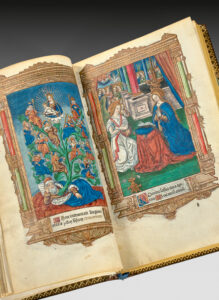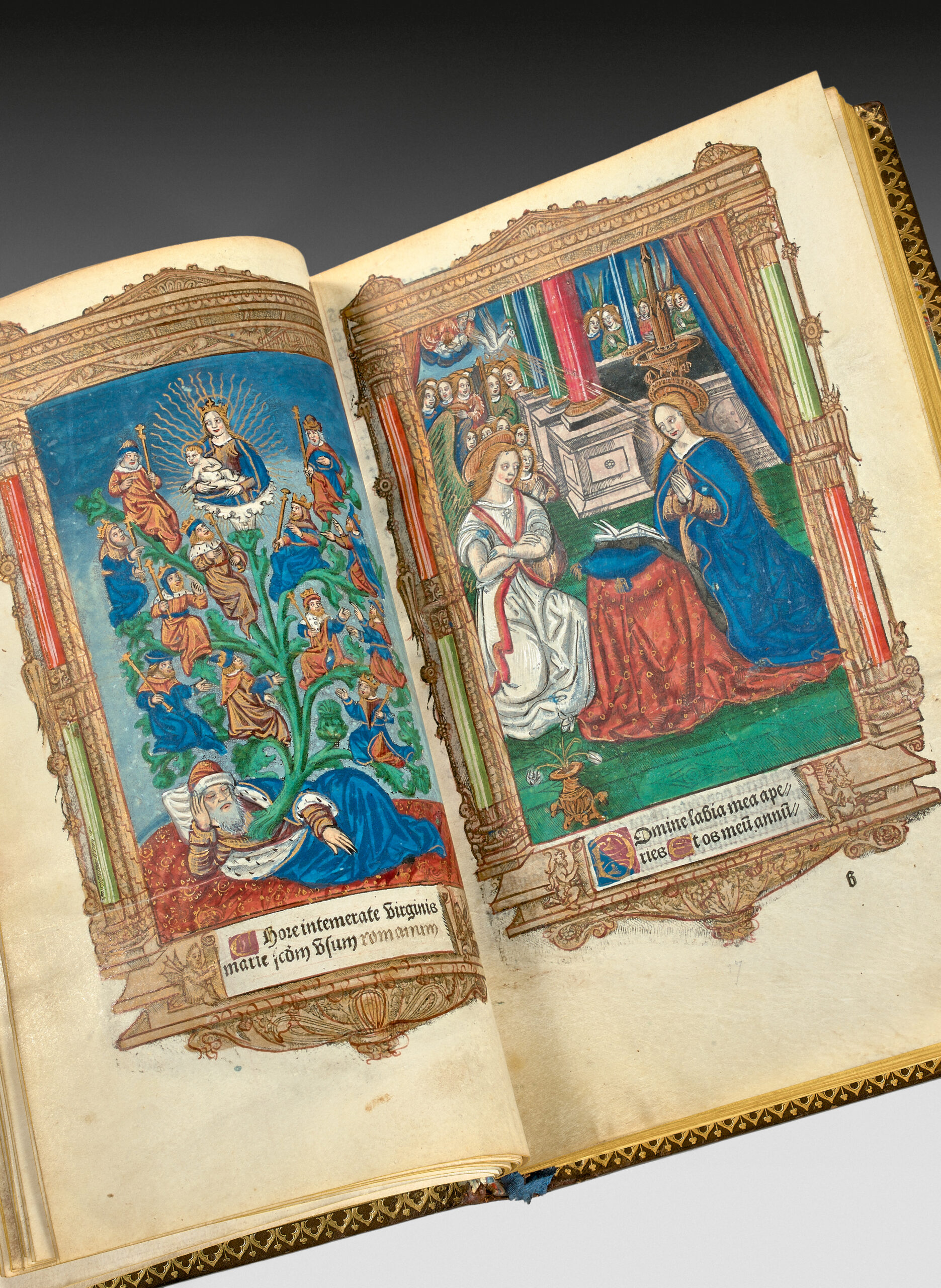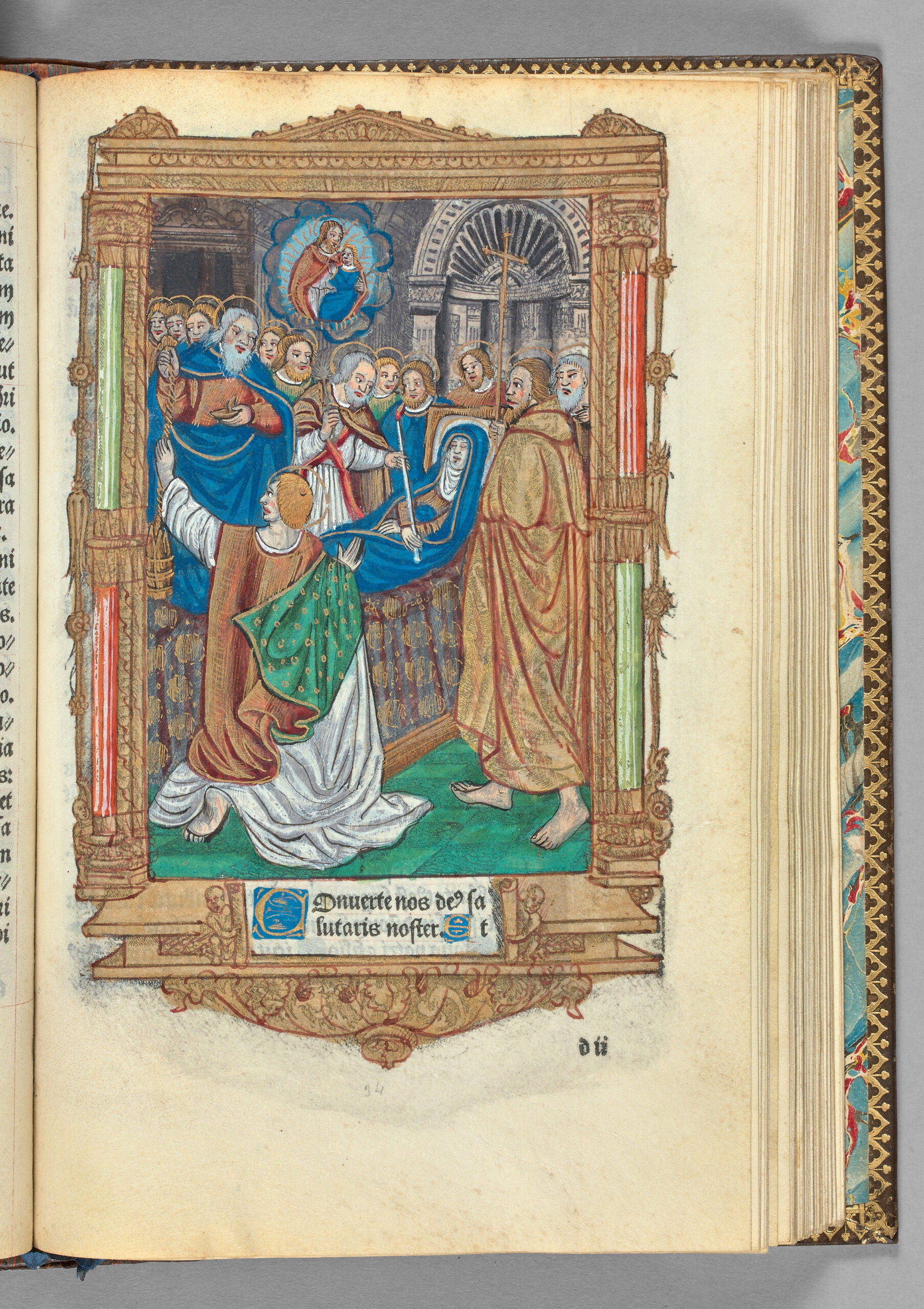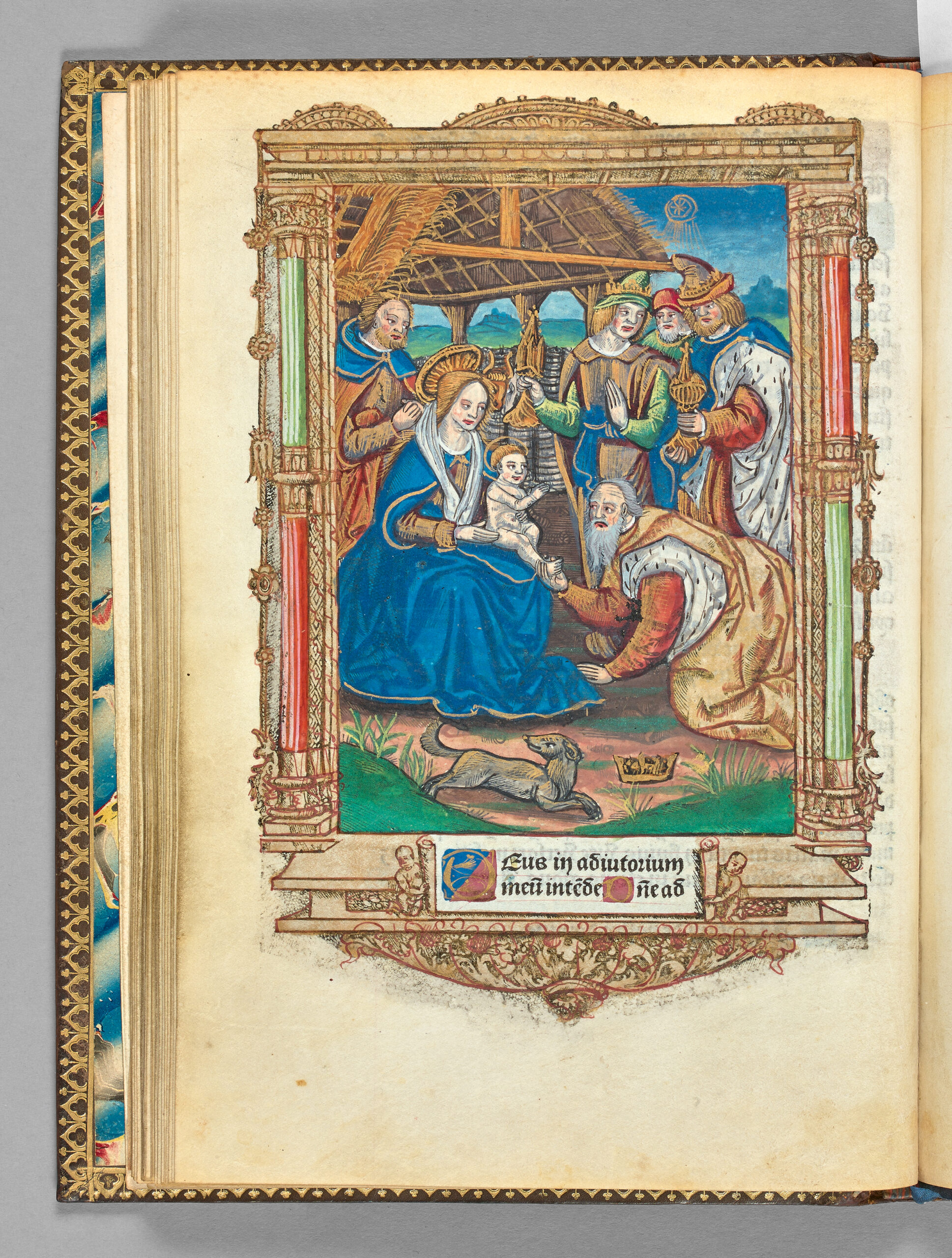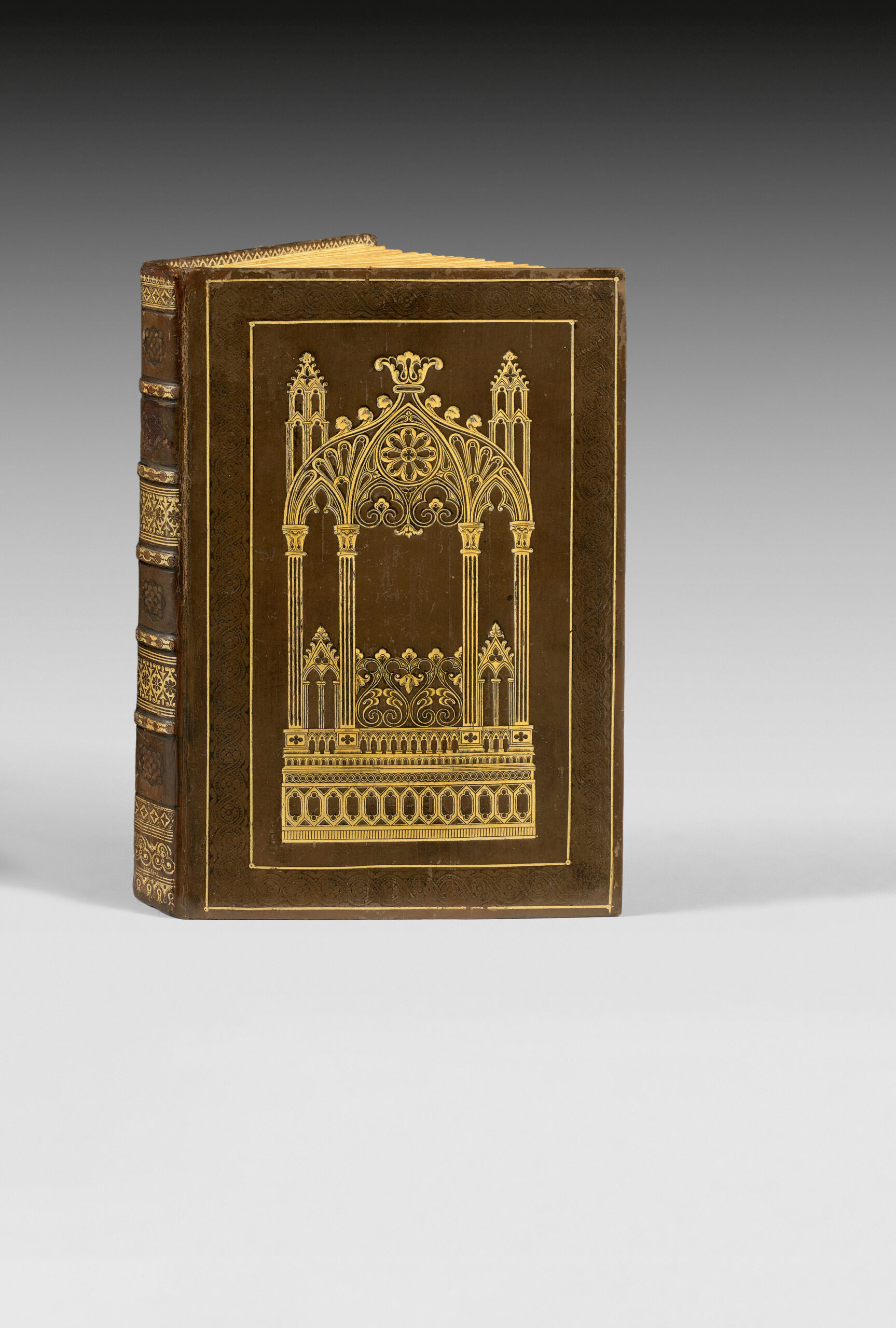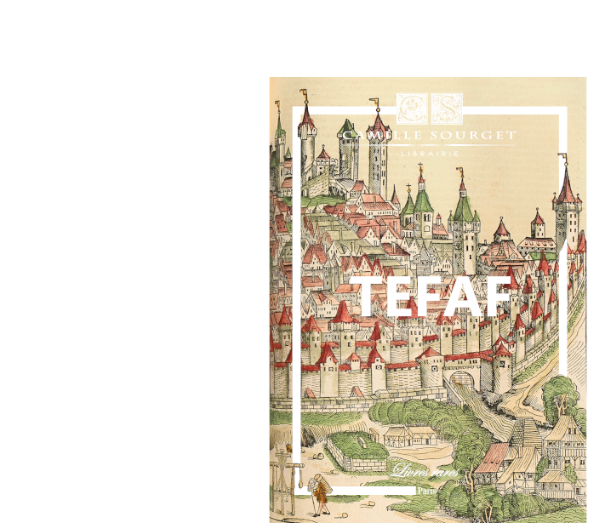Paris, Antoine Vérard. n.d.
Almanac for the years 1503 to 1520.
8vo of 98 leaves printed on vellum. 8 ll, a8, b8, c8, d6, e4, f8, g8, h8, i4, A8, B8, C12. Small pinhole in title-page. Brown calf, large gilt cathedral plate set in a blind-stamped frame and double gilt fillet, similarly decorated ribbed spine, gilt edges. Romantic binding.
221 x 136 mm.
Precious and exceedingly rare Parisian book of hours printed on vellum by Antoine Verard, the most renowned Parisian publisher from the end of the 15th century, unknown to Bohatta, Lacombe, Brunet, Tenschert, Nettekoven, Macfarlane.
The iconography comprises 16 large full-page woodcuts and 40 vignettes, in addition to Verard’s mark on the title and the figure of the anatomical man.
The subjects of the large engravings are borrowed from the New Testament, with the exception of 2 subjects.
– St. John and Aristodemus (184 x 125 mm). – Presentation in the temple.
– Kiss of Judas. – Massacre of the Innocents.
– Tree of Jesse. – Death of the Virgin Mary.
– Annunciation. – Crucifixion.
– King David. – Pentecost.
– Nativity. – David and Urea.
– Announcement to the shepherds. – Resurrection of Lazarus.
– Adoration of the Magi. – Trinity.
All these large figures were finely contemporary painted and enhanced with gold.
The 40 vignettes, also painted, are essentially devoted to the Lives of the Saints.
The copy, ruled in red ink, is entirely rubricated with gilt initials on an alternating red and blue background.
In the Bibliotheca Hulthemiana, n°604, a copy with 98 ll. is described (our copy?) “Ces heures si remarquables et qui sont inconnues au supplément de Brunet ont pour titre un écusson avec la légende d’Antoine Vérard au milieu duquel est un cœur inscrit du monogramme AVR au-dessus s’élèvent les trois fleurs de lys soutenues par deux anges.” (Bibliotheca Hulthemiana, 604).
The engravings are all enhanced in contemporary colors, reflecting the desire to get as close as possible to the aesthetic of illuminated manuscripts. The coloring is close to that of works associated with the workshop of the Master of the entrées parisiennes.
This edition is unusual in that its borders and margins are pure, with no engravings or ornamental compositions. It also combines two types of engravings, the older incunabula engravings based on models by the Master of the Très Petites Heures d’Anne de Bretagne (or Master of the Apocalypse, sometimes identified as Jean d’Ypres, son of Colin d’Amiens or Master of Coëtivy, active 1480-1510) commissioned for another bookseller Simon Vostre (8vo cycle for Vostre, circa 1495-1498, see Tenschert and Nettekoven, 2003) and those more in the Renaissance style, based on models by Jean Pichore (cycle produced for the 1503/1504 edition of Les Heures Pichore/De Laistre; another cycle produced for Gillet Hardouyn in 1505-1506, see Zöhl, 2004). Printed books of hours accounted for more than a quarter of Antoine Vérard’s overall output, and the present edition bears witness to the use of engraving cycles borrowed by Vérard from other bookseller-printers such as Vostre and Hardouyn. The dating of the present Hours is difficult to assess: although its Almanac covers the dates 1503-1520, the use of engravings after Pichore’s models, some of which can be dated after 1503/1504, suggests a slightly later dating for these Hours proposed by Vérard. If we accept, moreover, that certain other engravings after Pichore were first used by Hardouyn in 1505-1506 and only used by Vérard from 1507 onwards (see Macfarlane, no. 238; Tenschert and Nettekoven, 2003, vol. II, pp. 537 538), the date of the present edition should be postponed until after 1507. The almanac for the years 1503-1520 was used in a number of Vérard printings combining woodcuts after the Master of the Très Petites Heures d’Anne de Bretagne and those by Jean Pichore, e.g. The Hours at the use of Paris, Paris, Antoine Vérard, dated June 21, 1510 (see Tenschert and Nettekoven, 2003, vol. II, n°79). The coloring of the present Book of Hours and that of Tenschert (n°79) show real similarities and can be associated with the style of Jean Coene IV (Master of the entrées parisiennes), an illuminator active between 1500-1520, contemporary of Jean Pichore, studied by E. König and I. Delaunay.
Text:
Sig. [que]1 r, Title, with typographical mark by Antoine Vérard; sig. [que]1 v, Anatomical man and the four elements/temperaments; sig. [que]2 r, Almanach for 1503-1520; sig. [que]2 v-[que]8 r, Calendar; sig. [que]8 v-aa2v, Péricopes évangéliques; sig. aa3 r-aa8 r, Passion according to St. John; sig. aa8 v-d3 v, Hours of the Virgin (the text under the Jesse Tree reads: “Hore intemerate virginis marie secundum usum Romanum”, with the last word in ink); sig. d3 v-d6 v, Prayers, including Salve Regina; prayers for the deceased (missing sig. d7 and d8); sig. e1 r-e3 v, Office of the Virgin for Advent; sig. e3 v-e4 v, Hours of the Conception; sig. f1 r-f2 r, Hours of the Cross; sig. f2 v-f3 v, Hours of the Holy Spirit; sig. f4 r, Prayer, Suscipe sancta trinitas…; sig. f4 v-g5 v, Penitential Psalms and litanies, followed by prayers; sig. g6 r-i4 v, Office of the Dead and prayers; sig. A1 r-C2 v, Suffrages and prayers, of which Missus is Gabriel; Te deprecor; sig. C3 r-4v Office de la Conception de la Vierge ; sig. [a]1 r- [a]8 v, Sept psaumes : Sensuivent les sept pseaulmes en francoys translatez au plus pres en latin ; suivi des Sept prières de saint Grégoire : Les sept oraisons saint Gregoire.
Illustration:
These Hours include 16 large woodcuts: sig. [que] 8 v, Saint John the Evangelist and the poisoned cup before Aristodemus; sig. aa3 r, Judas’ kiss; sig. aa8 v, Jesse’s tree; sig. b1 r, Annunciation; sig. b4 v, Augustus and the prophecy of the Tiburtine Sibyl; sig. b8 v, Nativity; sig. c2 v, Annunciation to the shepherds; sig. c4 v, Adoration of the Magi; sig. c6 r, Circumcision; sig. c7 v, Massacre of the innocents; sig. d2 r, Dormition of the Virgin; sig. f1 r, Crucifixion; sig. f2 v, Pentecost; sig. f5 r, David and Uriah; sig. g6 r, Resurrection of Lazarus; sig. A1 r, Trinity and Ecclesia.
There follow 40 small enhanced woodcuts (some on metal?): sig. [que]1 v, four figures representing the four temperaments (choleric, melancholic, sanguine and phlegmatic); anatomical man. – sig. aa1 v, Saint Luke. – sig. aa2 r, Saint Matthew. – sig. aa2 v, Saint Mark. – sig. e1, Woman holding a rose. – sig. e3v, Pietà. – sig. f4v, Christ blessing. – sig. A1 v, Christ blessing; Christ of pity. – sig. A2 r, Pentecost; Veronica and the veil with the Holy Face. – sig. A2 v, Pietà. – sig. A5 v, Pietà. – sig. A6 r, Saint Michael. – sig. A6 v, Saint John the Baptist; Saint John the Evangelist. – sig. A7 r, saints Peter and Paul. – sig. A7 v, Saint James. – sig. A8 r, St. Stephen; St. Lawrence. – sig. A8 v, Saint Christopher. – sig. [B]1 r, Saint Sebastian. – sig. [B]1 v, Saint Nicolas; Saint Claude. – sig. [B]2 r, Saint Anthony. – sig. [B]2 v, Anne teaching the Virgin to read; Mary Magdalene. – sig. [B]3 r, Saint Catherine; Saint Marguerite. – sig. [B]3 v, Saint Barbara. – sig. [B]4 r, Saint Apolline. – sig. [B]5 v, Christ of mercy. – sig. [B]6 r, Christ blessing. – sig. [B]7 r, Pietà. – sig. C3 r, Pietà. – sig. [a] r, Christ blessing.
Bibliography :
Bohatta, H, Bibliographie der Livres d’Heures : Horae BMV, Officia, Hortuli Animae, Coronae BMV, Rosaria und Cursus BMV des XV und XVI Jahrhunderts, Vienna, 1924 ; Bonicoli, Louis-Gabriel, La production du libraire éditeur parisien Antoine Vérard (1485-1512) : nature, fonctions et circulation des images dans les premiers livres imprimés illustrés, Université Paris Ouest (thèse d’histoire de l’art sous la direction de Jean-Pierre Caillet), 2015 ; Delaunay, Isabelle, Échanges artistiques entre livres d’heures manuscrits et imprimés produits à Paris (vers 1480-1500), Université Paris-Sorbonne (thèse d’histoire de l’art sous la direction de Fabienne Joubert), 2000 ; Lacombe, P. Livres d’heures imprimés au XVe et XVIe siècle, conservés dans les bibliothèques publiques de Paris, Mansfield Centre (CT), 2002 (reprint) ; Macfarlane, J. Antoine Vérard, Londres, 1900 ; Maddocks, H, « A Book of Hours by Anthoine Vérard in the University of Melbourne Library », University of Melbourne Collections, issue 16, June 2015 ; Moreau, B., Inventaire chronologique des éditions parisiennes…tome I, 1501-1510, Paris, 1972 ; Nettekoven, Ina, Der Meister der Apokalypsenrose der Sainte Chapelle und die Pariser Buchkunst um 1500, Turnhout, 2004 ; Nettekoven, Ina, Heribert Tenschert et Caroline Zöhl. 365 gedruckte Stundenbücher aus der Sammlung Bibermühle. 1487-1586, Antiquariat Heribert Tenschert, 2015 ; Tenschert, H. et I. Nettekoven, Horae BMV. 158 Stundenbuchdrucke der Sammlung Bibermühle 1490-1550, H. Tenschert, 2003 ; Winn, Mary Beth, Anthoine Vérard: Parisian Publisher 1485-1512, Genève, 1997 ; Zöhl, C. Jean Pichore: Buchmaler, Graphiker und Verleger in Paris um 1500, Turnhout, 2004.
